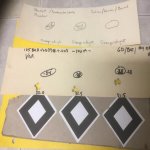I've been reloading since 1995, 26 years.
During that time, I kept 2 different logs. Just plain lined notebooks. Why 2 logs? Cuz at one time all I had was .30-06 and .338WM, so I had a book for each...
As I got more gear (Chrony), more and more rifles in different chamberings, my data got more and more jumbled.
I was putting some stuff in the .30-06 book, other stuff ended up in the .338WM log.
So the other day I got the idea to make spread sheets on the computer. Started off by creating a spread sheet with all the necessary info, and of course I used the same template for each cartridge I have loaded data for.
Then I went through both books, transcribed all those log entries onto spread sheets.
When I was done I was amazed at how terrible my data recording was! Like very inconsistent in recording all the pertinent stuff. Many of the entries don't list the case, c.o.a.l., what primer etc... Some didn't even have the particular bullet I had used.
And hardly any of the data from the shooting bench record group sizes.
About the only thing I was consistent on was recording velocities, when at the range, for the different loads I've tested.
The other observation was how nice it is to be able to look at a spread sheet, to see every single load I've tested, on the different cartridges. All right there on one page.
During that time, I kept 2 different logs. Just plain lined notebooks. Why 2 logs? Cuz at one time all I had was .30-06 and .338WM, so I had a book for each...
As I got more gear (Chrony), more and more rifles in different chamberings, my data got more and more jumbled.
I was putting some stuff in the .30-06 book, other stuff ended up in the .338WM log.
So the other day I got the idea to make spread sheets on the computer. Started off by creating a spread sheet with all the necessary info, and of course I used the same template for each cartridge I have loaded data for.
Then I went through both books, transcribed all those log entries onto spread sheets.
When I was done I was amazed at how terrible my data recording was! Like very inconsistent in recording all the pertinent stuff. Many of the entries don't list the case, c.o.a.l., what primer etc... Some didn't even have the particular bullet I had used.
And hardly any of the data from the shooting bench record group sizes.
About the only thing I was consistent on was recording velocities, when at the range, for the different loads I've tested.
The other observation was how nice it is to be able to look at a spread sheet, to see every single load I've tested, on the different cartridges. All right there on one page.









































































